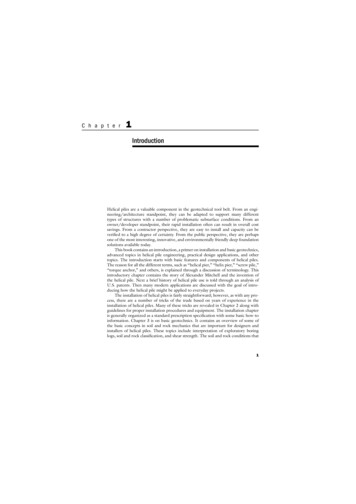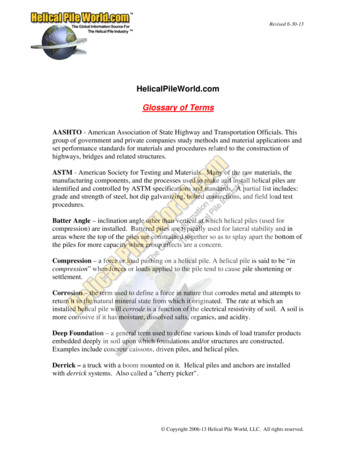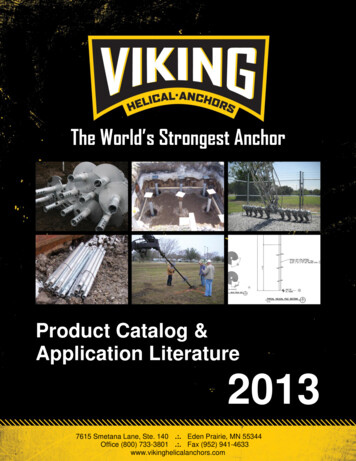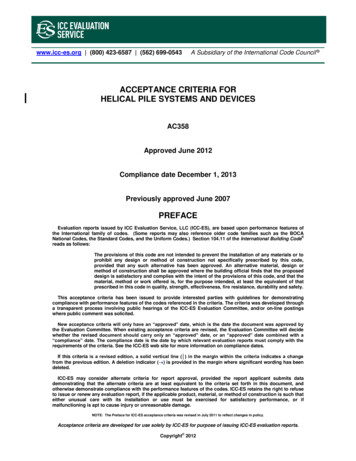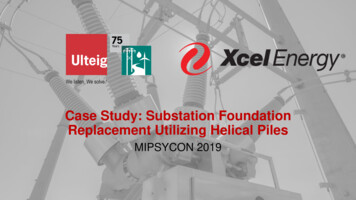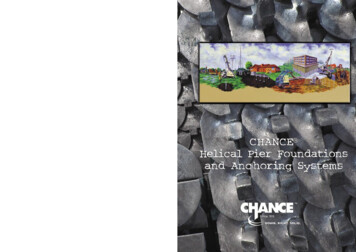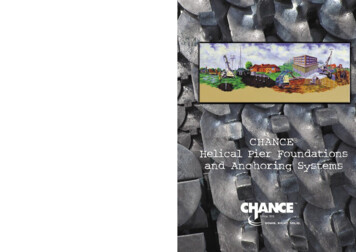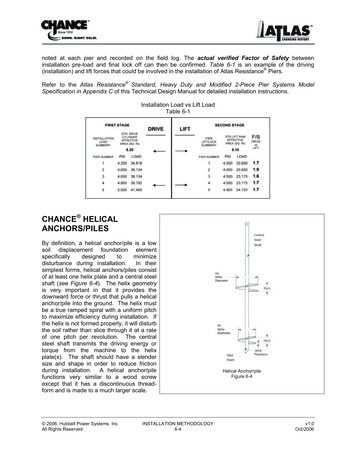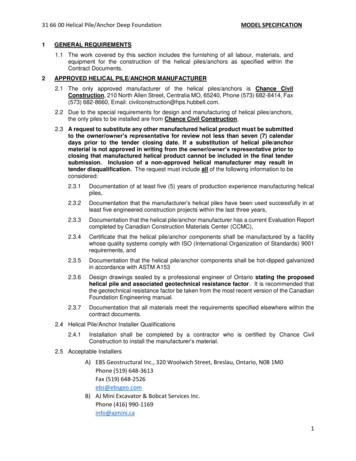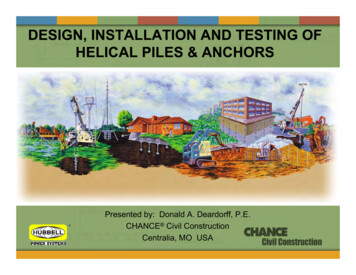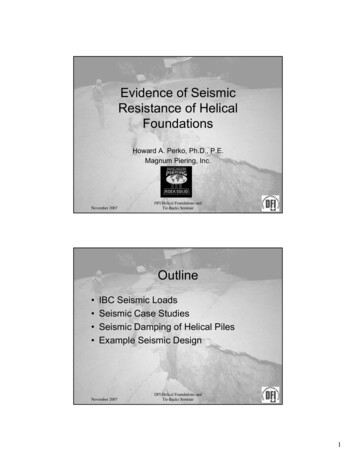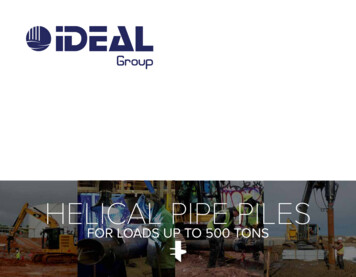
Transcription
HELICALPIPEPILESFOR LOADS UP TO 500 TONS
WHILE HELICAL PILES AND THE ASSOCIATEDMETHODS HAVE BEEN USED FOR MANY DECADES,THE IDEAL APPROACH IS ANYTHING BUT ANTIQUATED.We believe that although it isn’t broken, there’s always room for improvement.We pioneered the high capacity helical pile industry and today we manufacturehelical piles with shaft diameters up to 36”. Leave behind any misconceptionsyou had about helical piles and see what IDEAL has to offer. We’re going places.
BRACKET ORLOAD TRANSFERDEVICE (LTD)GET FAMILIARThe unit is called a helical pier if it resists compressive loads,which are usually downward. It is called a helical anchor ifit resists tensile loads, which are usually upward or inclined.Many helical units function as both piers and anchors.EXTENSIONBOLTEDCOUPLINGA helical unit is installed by simply screwing it into the ground.The central shaft may be round or square and it may be hollowor solid. Hollow (pipe shafts) are often preferred, because theyprovide a greater section modulus for the same cross-sectionalarea of steel. Pipe shafts, as compared to solid shafts,generally provide greater resistance to installation torques andbuckling under compressive loads.Our team is often called on tofabricate custom brackets andload transfer devices. Beloware examples of bracketswhich are manufactured byIDEAL. Give us a call if youdon’t see what you’re lookingfor and we can design theperfect bracket to meet yourunique project requirements.SEWER PIPELINE SUPPORTA typical helical unit is shown to the left. It consists of acentral steel shaft, to which can be attached one or moresteel helices. The central shaft can be lengthened by addingextension pieces as necessary.Pipe shafts range anywhere from 2 7/8”” to 36” in diameter,and helices range anywhere from 5” to 48” in diameter andare seldom less than 3/8” thick.LEAD SECTIONExperience and theory have combined to suggest that thepreferred spacing between multiple helices is equal to 3 helixdiameters of the preceding helix.HELIXSUPPORT OF EXCAVATIONThe final component to the helical unit is the Load TransferDevice (LTD). This is used to transfer the tension orcompression load from the structure to the helical unit.Simply put, the helical unit transfers tension or compressionload to competent soil strata below incompetent soils. 2020 Ideal Manufacturing Inc.CLEARSPAN BRACKET
APPLICATIONSA helical pier is a deep foundation. Its purpose is to transfer a structural load to deeper, stronger, and less compressible materialsbypassing any weaker and more compressible materials that would be unsuitable for the support of conventional shallow foundations.As a deep foundation, a helical pier should be considered for most applications that would call for a driven pile, drilled pier, or mini pile.Helical piles and anchors are usually a great foundation solution to any of the applications below whether it’s a new build orexisting structure.CELLULAR TOWERSPIPE RACK SUPPORTCOMMERCIAL UNDERPINNINGNEW CONSTRUCTIONINTERIOR RETROFITTANK FOUNDATIONS
COMMERCIAL BUILDING REMEDIATIONSUBSTATIONSTIE-BACKS/ANCHORS/RETAINING WALLSSANITARY PIPELINE SUPPORTLIGHTING 50FTBULKHEADSSUPPORT OF EXCAVATIONSOUND WALLSSHORING PIPELINEWORK CAMP FOUNDATIONSBRIDGES/BOARDWALKS/DOCKSGUY LINES/WIRESTOWERS – QUAD BASEROADWAY SIGNAGE TRAFFIC SIGNALSTANKS AND SILOSTOWERS – MONOTUBEBILLBOARD/SIGNAGE GENERATOR BASESUNDERWATER SUPPORTUTILITY ANCHORINGTIE-DOWNS/MOORINGSMACHINE BASESBRIDGE REMEDIATIONMUNICIPAL BOARDWALKSRETAINING WALLS/SHORINGCLEARSPAN STRUCTURESMACHINE BASESSANITARY PIPELINE SUPPORT
ADVANTAGESFor many applications helical units may offer significant advantages over other systems. Some of these include:WIDERANGE OF LOADSA wide range of allowable loads. Anywhere from 10-500 tons to be exact.VERSATILEINSTALLATION ANGLESAdaptability to a variety of installation angles to accomodate compression, tension, lateral, and overturn.VARIETY OF INSTALL ANGLESLESSDEPTH MORE MONEYLower cost than driven or drilled piles. While the cost per foot may be higher, piles can be installed to lesser depths andreach the same required capacities.RAPIDINSTALLATIONNot quite lightning fast, but it’s hard to beat the ease and speed of installation.MINIMALEQUIPMENTMinimal support equipment is needed for installation. A drive head, torque indicator, and a few other components andyou’re up and running. Just by the way, IDEAL offers the most complete drive head packages in the industry.GREATFOR LIMITED ACCESSHelical piles are great for low-headroom and other limited-access areas inside, underneath, and in between existingstructures.SIMPLECUTOFFSWIth a band saw or torch, on-site cut-offs are a breeze.EXTREME WEATHERNOCONCRETE DELAYSNo concrete-related delays, and we all know time is money.INSTALLIN EXTREME WEATHERHelical piles can be installed in any weather except thunderstorms and whatnot. We play it safe, and you should too.LIMITEDEARTHWORK AND NO SPOILSLittle or no earthwork or spoil material is created during helical pile installation. This is a huge advantage when working atcontaminated sites.MINIMALVIBRATION AND NOISEWith minimal vibration and noise, helical piles are a perfect fit for historic structures and other urban projects surrounded byfragile people and buildings.TEMPORARYINSTALLATIONSEasily removed and reused in temporary applications such as shoring and movable structures.LOWMOBILIZATION COSTVery low mobilization and demobilization costs. Look at the real costs of installing alternates and you might be as surprisedas we were when we did the math.LIMITED ACCESS
INSTALLINGTHE HISTORYA helical screw pile is rotated into the ground byusing a hydraulic drive head, powered by an excavator,pile driving rig, or any other equipment with hydrauliccapability. IDEAL requires installers to monitorinstallation torque and pile alignment during theinstallation process. This is required for a few reasons.The first helical screw pile was invented in the 1830’s by a blind Irish marineconstruction engineer named Alexander Mitchell. His design proved to be amajor improvement over traditional straight pile designs, so Mitchell and hisson promptly patented the cast iron screw pile. In 1840 the first screw pileswere installed to support the Maplin Sands lighthouse at the mouth of theThames River. This innovative design caught on and made its way acrossthe pond quickly and before long most of the lighthouses in theMid-Atlantic region were being built on helical pile foundations. There weremore lighthouses built on helical pile foundations in Chesapeake Bay thananywhere else in the world. A total of Forty-two helical screw pilelighthouses were built on Chesapeake Bay between 1850 and 1900.First, it is important to have a qualitative assessmentof the soils being penetrated at various depths. Usinga graph, the recorded installation torque and depth isinterpreted against the existing soil data to obtain acorrelation that enables a simple verification strategy tobe determined.The soil data is interpreted against the installationtorque and a correlation is obtained to maintain theintegrity of the helical screw pile during installation aswell as mitigate damage by exceeding the allowedtorsional strength to any of the pile’s components.Every helical screw pile has a maximum stress levelthat must not be exceeded in order to avoidcompromising the structural integrity of the helicalscrew pile unit.The helical screw pile technology didn’t stay on the east coast. Over thenext few years, helical screw pile lighthouses could also be found in theGreat Lakes Region and the Gulf of Mexico.The foundation of a typical screw pile lighthouse consisted of one centralpile installed in the center and then flanked by another six or eight pilesaround the perimeter. This design increased the anchoring properties andthe bearing power of the helical screw piles. These early helical screw pileswere often installed by using large torque bars and the power of men,horses, or oxen.Alexander Mitchell’s helical screw pile design is just as effective today as itwas in the late 18th century and continues to be installed around the world.MAPLIN SANDS LIGHT 2020 Ideal Manufacturing Inc.EARLY HELICAL PILE
OUR MISSIONTo provide our clients and associates with proprietary technology,products, equipment, and support, ensuring excellence in the designand performance of deep foundation and earth anchoring projects.IDEAL Manufacturing, Inc. 80 Bluff Drive, East Rochester, NY 14445 800.789.4810 www.idl-grp.com
The unit is called a helical pier if it resists compressive loads, which are usually downward. It is called a helical anchor if it resists tensile loads, which are usually upward or inclined. Many helical units function as both piers and anchors. A helical unit is installed by simply screwing it into the ground.
